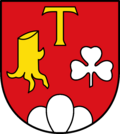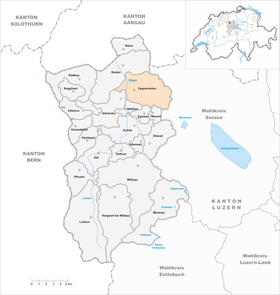Dagmersellen
| Dagmersellen | |
|---|---|
| State : |
|
| Canton : |
|
| Constituency : | Willisau |
| BFS no. : | 1125 |
| Postal code : | 6211 Buchs 6252 Dagmersellen 6253 Uffikon |
| UN / LOCODE : | CH DAE |
| Coordinates : | 641 727 / 229271 |
| Height : | 479 m above sea level M. |
| Height range : | 458–770 m above sea level M. |
| Area : | 23.87 km² |
| Residents: | 5504 (December 31, 2018) |
| Population density : | 231 inhabitants per km² |
|
Proportion of foreigners : (residents without citizenship ) |
14.9% (December 31, 2,015) |
| Website: | www.dagmersellen.ch |
| Location of the municipality | |
Dagmersellen ( Swiss German Dammerselle [ˈdamːərseɫːə] ,) is a municipality in the Swiss canton of Lucerne . It is in the constituency of Willisau .
The old municipality of Dagmersellen was territorially distinctive on January 1, 2006 through the merger with the former municipalities of Buchs and Uffikon, increasing its population by around a third.
geography
Dagmersellen is located in the Swiss plateau on the banks of the Wigger . The community borders in the west and north on Reiden , in the east on Triengen , in the north-east on Knutwil , in the south-east on Mauensee , in the south on Wauwil , Egolzwil and Nebikon and in the south-west on Altishofen .
history
The place name Dagmersellen is a combination of the Old High German male personal name Dagemar, Tagemar with the Old High German generic word salida "Herberge , Behausung " and means "with the dwellings of Dagemar" - which referred to an early Alemannic settler. The oldest forms recorded in writing are several centuries younger and are Tagmarsellen (1070-1090, later copy), in Tagemarsseldon (1173) and Tagemarsselidon (1223).
Dagmersellen entered history in 1076. At that time the greater part of the village belonged to the barons of Wolhusen , who had other possessions in the Wiggertal. Together with other nobles, they secured the border against the Burgundian Empire with castles. During this time, a wooden castle was probably built on the Gäitschiflüeli. Baron Seliger entered Einsiedeln as a monk and bequeathed his estates in Dagmersellen, Ettiswil, Wauwil and Egolzwil to the monastery in the Dark Forest.
At the hermit Dinghof , the abbot, or his deputy, held court twice a year. In 1334, Hans Waldmann, Zurich's mayor, served as a hermit canon in Tagmarsellen.
In 1262 Abbot Heinrich granted the bailiwick of the Dinghof to the nobles of Trostberg. They also owned some estates and a moated castle in the community (today the Steiner family's farm on Kreuzbergstrasse, where the former moat can still be seen on the east side). This castle must have been destroyed in the time before the Sempach War. On May 18, 1679, the reclusive goods came to Lucerne. This rounded off the Lucerne possessions in the northwestern part of the canton. In August 1798 Dagmersellen was occupied by the French army.
The 19th century is the time of industrialization. In 1858 Hermann and Carl Senn von Zofingen opened a silk ribbon weaving mill with 96 looms in Sagen . An art mill followed in 1865, and three years later a cotton weaving mill was built on the municipal boundary.
The direct main road Dagmersellen – Reiden was laid out in 1849. The construction of the Centralbahn in 1855 brought about a big change for the village. In 1980 the A2 motorway was opened and brought the village a noticeable relief from through traffic.
On January 1, 2006, the neighboring communities of Uffikon and Buchs were incorporated into Dagmersellen. At the end of November 2004, the electorate in the three municipalities clearly approved this step: In Dagmersellen with 960: 263 votes (participation 56.4%), in Uffikon with 306: 52 (73.3%) and in Buchs with 196: 16 ( 78.9%).
population
| Population development | |
|---|---|
| year | Residents |
| 1798 | 1,281 |
| 1850 | 2'005 |
| 1900 | 1,761 |
| 1950 | 2,019 |
| 1960 | 2,287 |
| 1970 | 2,770 |
| 1980 | 2,667 |
| 1990 | 3,028 |
| 2000 | 3,311 |
| 2004 | 3,252 |
| 2006 | 4,554 |
| 2008 | 4,847 |
| 2014 | 5'118 |
| 2018 | 5'504 |
The population increased considerably by 1850 (1798–1850: +56.5%). It then fell in two steps until 1900 as a result of emigration (1850–1900: −11.2%), but not as sharply as in many other rural communities at that time. By 1950 it then slowly grew again to the level of 1850. After that, the population increased sharply within half a century (1950–2000: +64.0%). As a result of the 2006 merger with Uffikon and Buchs, the population continued to grow. Of the total number of residents, 680 lived in Uffikon and 386 in Buchs.
languages
The population speaks a highly Alemannic dialect as everyday language . At the last census in 2000, 89.22% said German, 2.54% Albanian and 2.14% Italian were the main languages.
Religions - denominations
In the past, all residents of the parish were members of the Roman Catholic Church. Today (as of 2000) the religious landscape is as follows: 81.12% of the population are Roman Catholic , 7.97% Evangelical Reformed and 2.75% Orthodox Christians. There are also 2.39% non-denominational, 2.23% Muslim and 0.30% Hindus. With the exception of a few Bosniaks, the Muslims are all Albanians from Kosovo and Macedonia. The Hindus are Tamils from Sri Lanka.
Origin - nationality
At the end of 2018, of the 5,504 inhabitants, 4,646 were Swiss and 858 (= 15.6%) were foreigners. The population consisted of 85.8% Swiss citizens. At the end of 2014, the foreign residents came from Serbia including Kosovo (23.8%), Portugal (23.1%), Germany (19.2%), Italy (15.5%), Spain (1.8%) and the Turkey (1.2%). 11.7% came from the rest of Europe and 3.7 % came from outside Europe.
politics
Municipal council
The Dagmersellen municipal council consists of five members and is set up as follows:
- Philipp Bucher ( FDP ): Mayor
- Urs Fellmann ( CVP ): Construction department
- Susanne Hodel-Schumacher (independent): Social Affairs
- Markus Riedweg (CVP): Education department
- Luzia Kurmann Schaffer (CVP): Finance department
Cantonal elections
In the 2015 cantonal elections in the canton of Lucerne, the share of the vote in Dagmersellen was: CVP 38.7%, SVP 26.5%, FDP 24.3%, SP 6.6%, GPS 1.0%, glp 1.0%.
National Council elections
In the 2015 Swiss parliamentary elections, the share of the vote in Dagmersellen was: SVP 32.5%, CVP 31.5%, FDP 20.1%, SP 7.7%, Greens 3.1%, glp 2.8%, BDP 1, 1 %.
economy
The following companies are among others in Dagmersellen:
Bekon Koralle AG, Emmi Milch AG, Gezolan AG, Hugo Willimann AG, Josef Arnet AG, JT International AG ( Japan Tobacco ), Pan Gas AG, Aldi Suisse , Galliker Transport AG, Nestlé AG, Hiestand AG, Jumbo, training and administration center of the Swiss Record Association SPV.
traffic
Dagmersellen has a train station on the important north-south route of the Swiss Federal Railways from Olten to Lucerne and is served by regional trains and the S8 line from Olten to Sursee .
There are also two bus routes, one of which connects Dagmersellen with Sursee and the other Dagmersellen with Nebikon, Schötz and Ebersecken.
The village is on the north-south motorway connection A2 .
Art, culture, customs & club life
Since 1994, the community has been awarding a "cultural chunk" to associations, institutions or individuals who help shape cultural life in Dagmersellen through their work and work. The culture lump in the amount of the respective year, for 2010 CHF 2010, is to be understood as recognition and appreciation as well as an incentive to continue to work for the cultural design of the living space of Dagmersellen.
The controversial art project Tempelhof Uffikon is located in the community and is described as a fantastic 113,000 square meter total work of art.
The tradition of the Giritzenmoos court once practiced here died out in the 1870s.
The following clubs should be mentioned: FC Dagmersellen, Musikgesellschaft Dagmersellen, Beerebiisser Dagmersellen, Häppereschweller Dagmersellen, Jungwacht and Blauring Dagmersellen, Adult Education Center Dagmersellen, Navo, Feldschützengesellschaft Dagmersellen, Ski-Club Dagmersellen SCD, Sportverein Uffikon, TC Dagmersellen, TVD, TVD -Club Dagmersellen, hiking group Wiggertal Dagmersellen, Handharmonika-Club Dagmersellen and surroundings, Brass Band Uffikon-Buchs.
Attractions
Personalities
- The journalist Guido Mingels was born in Dagmersellen.
- The wheelchair racer Edith Hunkeler lives with her family in Dagmersellen.
photos
Literature and web links
- Official website of the municipality of Dagmersellen
- Community profile of the cantonal statistical office (PDF, 112 kB)
- Waltraud Hörsch: Dagmersellen. In: Historical Lexicon of Switzerland .
Individual evidence
- ↑ Permanent and non-permanent resident population by year, canton, district, municipality, population type and gender (permanent resident population). In: bfs. admin.ch . Federal Statistical Office (FSO), August 31, 2019, accessed on December 22, 2019 .
- ↑ Permanent resident population by nationality category, gender and municipality ( memento from January 1, 2015 in the Internet Archive ) (permanent resident population)
- ^ Linguistic Atlas of German-speaking Switzerland , Volume V 1b.
- ↑ Lexicon of Swiss municipality names . Edited by the Center de Dialectologie at the University of Neuchâtel under the direction of Andres Kristol. Frauenfeld / Lausanne 2005, p. 285.
- ↑ Balance of the permanent resident population according to demographic components, institutional structure, nationality and gender (Federal Statistical Office, STAT-TAB)
- ^ LUSTAT: Selected key population figures since 1991
- ^ LUSTAT: Community profile Dagmersellen ( Memento from May 8, 2016 in the Internet Archive )
- ↑ National Council elections 2015: strength of the parties and voter turnout by municipality. In: Results of the National Council elections 2015. Federal Statistical Office, 2016, accessed on June 3, 2016 .
- ↑ See JL Arnold: The "Giritzenmoos" in Dagmersellen (Canton Lucerne). In: Swiss Archives for Folklore, Vol. 7 (1903), pp. 295–298.









